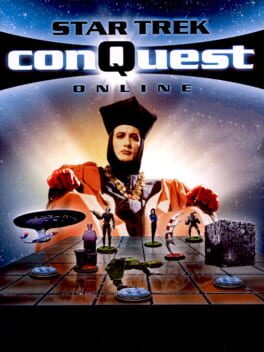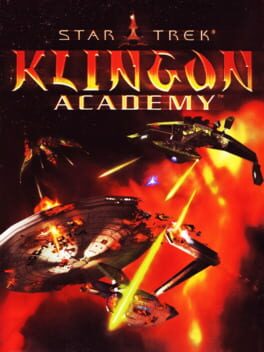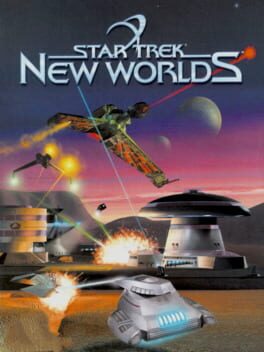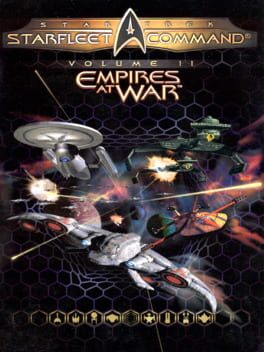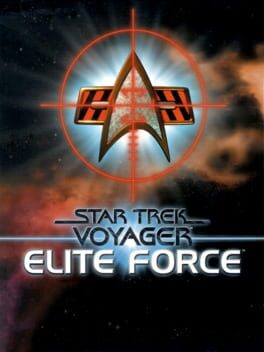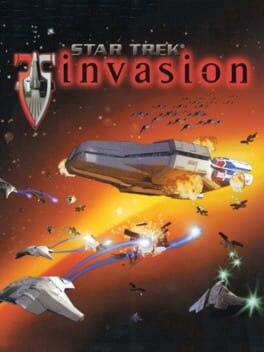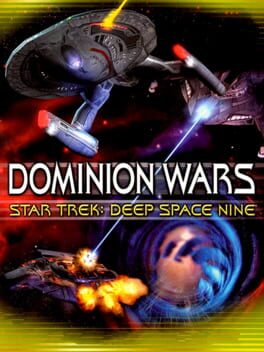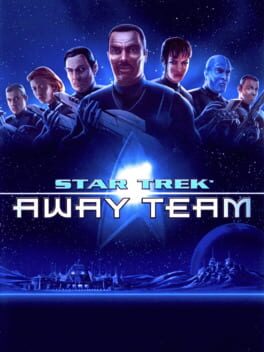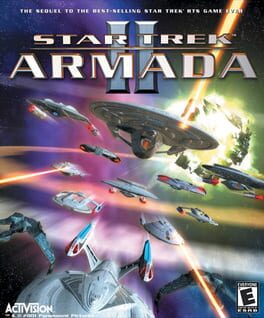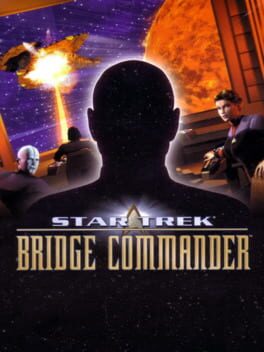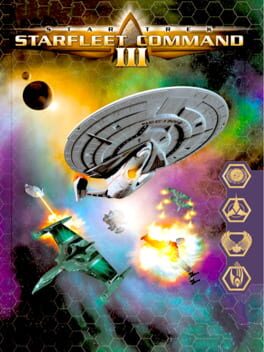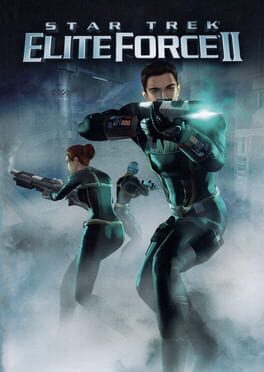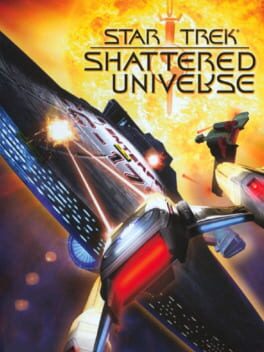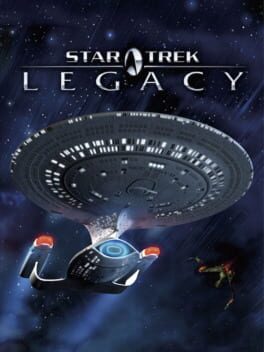Cube1701
Unfortunately, I can’t get the full experience of this game as it’s an online focused game and the servers are down. That said, you can still play the tutorial and battle against an AI, just without the full features of the game, so I can at least get a taste of what the game is.
ConQuest is some kind of digital board game where you play as a Q battling other Q using pieces from the galaxy. Each turn goes through phases where you plan your actions, which then occur at the same time as your opponent. The deploy phase is where you bring in more pieces from your collection: these can be personnel, ships or items that can be attached to them.
The next phase is combat. If you have ships/people in the same place at others, you can fight. However, any attacking ships can not defend. The last phase is the movement phase, where you use the actions of your pieces, which is mainly beaming people to/from planets and ships, the planets being key to victory. The map will have your planet, the opponent’s planet and then 1 or 3 planets in the “Neutral Zone”. You need influence to control these planets, which generate control points to spend on bringing new pieces into the game. The overall objective is to trap the enemy Q on a planet you control for one turn.
There’s also a more advanced game which adds some more steps and changes the objective. The first new step is the auction phase, which is where events come into play. For good events, you take turns bidding. For negative events, you both bid in secret. There’s also a “Special” phase where you use the bonus abilities of characters – the Borg Queen, for example can assimilate opponent pieces. You can also generate more control points to spend next turn or generate Q points. These Q points are the path to victory in the advanced game.
ConQuest Online is a well thought out strategy game and it’s a shame that the game is server dependant and doesn’t allow for setting up your own matches. It also means that you are stuck with just using the starter Federation pieces when playing against the AI – you can’t get more pieces or the packs from the other factions.
ConQuest is some kind of digital board game where you play as a Q battling other Q using pieces from the galaxy. Each turn goes through phases where you plan your actions, which then occur at the same time as your opponent. The deploy phase is where you bring in more pieces from your collection: these can be personnel, ships or items that can be attached to them.
The next phase is combat. If you have ships/people in the same place at others, you can fight. However, any attacking ships can not defend. The last phase is the movement phase, where you use the actions of your pieces, which is mainly beaming people to/from planets and ships, the planets being key to victory. The map will have your planet, the opponent’s planet and then 1 or 3 planets in the “Neutral Zone”. You need influence to control these planets, which generate control points to spend on bringing new pieces into the game. The overall objective is to trap the enemy Q on a planet you control for one turn.
There’s also a more advanced game which adds some more steps and changes the objective. The first new step is the auction phase, which is where events come into play. For good events, you take turns bidding. For negative events, you both bid in secret. There’s also a “Special” phase where you use the bonus abilities of characters – the Borg Queen, for example can assimilate opponent pieces. You can also generate more control points to spend next turn or generate Q points. These Q points are the path to victory in the advanced game.
ConQuest Online is a well thought out strategy game and it’s a shame that the game is server dependant and doesn’t allow for setting up your own matches. It also means that you are stuck with just using the starter Federation pieces when playing against the AI – you can’t get more pieces or the packs from the other factions.
Unfortunately, I couldn’t fully enjoy the full extinct of this game due to my colourblindness. The interface colours, while fitting in with the Klingon style, makes it almost impossible for me to read any of the words in the HUD. Even lowering the resolution to make the HUD appear larger didn’t help, so I had to refer to the manual for the list of button presses I needed for the interface system in order to play.
Klingon Academy a follow on from Starfleet Academy, with similar gameplay. The bridge view is removed, instead offering a first person or third person view of the ship. While it was nice to look at, it was better playing in the first person view anyway. Klingon Academy introduces a “Verbal Orders System”, which uses all the number keys to give a large list of commands, requiring 3 or 4 button presses. It’s not very easy to do while in the middle of combat using a joystick to fly around. You can order your helm officer to fly, but they’ll crash the ship.
It’s a shame as there’s a lot of advanced tactics buried deep in this system. You can send marines to capture enemy ships overload shields and weapons for a short boost but risking damage and subsystem targeting – this feature would be better refined in Bridge Commanded, aided by your officers not being awful at piloting the ship.
The piloting issues also extend to the enemy. While Klingons are known for ramming as a last resort, the Federation (well, simulated Federation) in this seem to love it, with collisions running a lot of missions. You have even more options available to you by using nearby phenomena such as gas giants and planetary rings to your advantage. It’s a shame that there’s so much depth, yet most battles end up slowly pummelling each other while circling close with you trying to avoid getting rammed.
Throughout the game you’ll be treated to a ton of live action clips starring Christopher Plummer and David Warner as Chang and Gorkon, who do a wonderful job and the game gives a great insight into Klingons, as well as serving as a prequel to The Undiscovered Country. There’s a lot to like about Klingon Academy, it’s just a shame about the interface and enemy AI.
Klingon Academy a follow on from Starfleet Academy, with similar gameplay. The bridge view is removed, instead offering a first person or third person view of the ship. While it was nice to look at, it was better playing in the first person view anyway. Klingon Academy introduces a “Verbal Orders System”, which uses all the number keys to give a large list of commands, requiring 3 or 4 button presses. It’s not very easy to do while in the middle of combat using a joystick to fly around. You can order your helm officer to fly, but they’ll crash the ship.
It’s a shame as there’s a lot of advanced tactics buried deep in this system. You can send marines to capture enemy ships overload shields and weapons for a short boost but risking damage and subsystem targeting – this feature would be better refined in Bridge Commanded, aided by your officers not being awful at piloting the ship.
The piloting issues also extend to the enemy. While Klingons are known for ramming as a last resort, the Federation (well, simulated Federation) in this seem to love it, with collisions running a lot of missions. You have even more options available to you by using nearby phenomena such as gas giants and planetary rings to your advantage. It’s a shame that there’s so much depth, yet most battles end up slowly pummelling each other while circling close with you trying to avoid getting rammed.
Throughout the game you’ll be treated to a ton of live action clips starring Christopher Plummer and David Warner as Chang and Gorkon, who do a wonderful job and the game gives a great insight into Klingons, as well as serving as a prequel to The Undiscovered Country. There’s a lot to like about Klingon Academy, it’s just a shame about the interface and enemy AI.
A few months after Star Trek Armada came out, we got another real time strategy game set in the Star Trek universe. This is a more traditional ground based one similar to Command & Conquer. Star Trek isn’t exactly known for large scale ground combat, so this takes a lot of liberties.
It’s set in a new solar system thar suddenly appeared after a Romulan’s weapons test went wrong. As the location happens to be on an intersection of Federation, Klingon and Romulan territory, it’s a good opportunity for them to colonise this new world and kill each other for its resources. You eventually encounter a race that already lives on the planet, so you kill them, too. With all these random ground vehicles, recognisable Star Trek elements and designs are few and far between.
The best thing about this game is the camera. There’s a lot of options for moving the camera around and looking at the fully 3D landscape. It seems odd to praise a camera, but I’m having a hard time thinking of other good things to say about this game, other than the opening and ending FMV cutscenes.
The gameplay is extremely tedious. One major RTS element this game throws out is the fog of war system. You can see the landscape of the whole area, but can only see objects near your units. This means that you have absolutely no idea which parts of the map you have previously explored. Units are also very slow at responding and it can take minutes for them to travel where they need to go. This game really needed speed options due to how long everything takes.
To make matters worse, these very long missions have to be completed in one go, as there’s no save feature at all – only which missions you’ve unlocked. There are also six different resources to manage, as well as moving officers to locations to complete objectives being a massive faff.
It’s set in a new solar system thar suddenly appeared after a Romulan’s weapons test went wrong. As the location happens to be on an intersection of Federation, Klingon and Romulan territory, it’s a good opportunity for them to colonise this new world and kill each other for its resources. You eventually encounter a race that already lives on the planet, so you kill them, too. With all these random ground vehicles, recognisable Star Trek elements and designs are few and far between.
The best thing about this game is the camera. There’s a lot of options for moving the camera around and looking at the fully 3D landscape. It seems odd to praise a camera, but I’m having a hard time thinking of other good things to say about this game, other than the opening and ending FMV cutscenes.
The gameplay is extremely tedious. One major RTS element this game throws out is the fog of war system. You can see the landscape of the whole area, but can only see objects near your units. This means that you have absolutely no idea which parts of the map you have previously explored. Units are also very slow at responding and it can take minutes for them to travel where they need to go. This game really needed speed options due to how long everything takes.
To make matters worse, these very long missions have to be completed in one go, as there’s no save feature at all – only which missions you’ve unlocked. There are also six different resources to manage, as well as moving officers to locations to complete objectives being a massive faff.
In order to get this to work, I had to play a version of the standalone expansion Orion Pirates, released in 2001. This version has all the content from the base game added, but also some graphical enhancements – but the important thing is that it’s still the original gameplay.
For the most part, it’s the same game as the first. People who know the game extremely well will probably notice various balance changes and additional features, but the game is so in depth that it’s still beyond my understanding. The second game does introduce some new races (including one originally created for the Star Fleet Battles board game) and a new campaign mode.
In the campaign mode, you explore hex tiles until you encounter missions, some are optional while others you must play before moving on. It all looks very impressive, with different hubs for your race and other races, ships moving around and races that are allied with you, but almost all of this is fluff to make it appear interesting and doesn’t impact the game: you just move around and encounter random missions.
For people who like the depth of the combat in this, this version is definitely a really good version to play. You can pick scenarios, modify them or accept the campaign for what it is and have fun with the random missions.
For the most part, it’s the same game as the first. People who know the game extremely well will probably notice various balance changes and additional features, but the game is so in depth that it’s still beyond my understanding. The second game does introduce some new races (including one originally created for the Star Fleet Battles board game) and a new campaign mode.
In the campaign mode, you explore hex tiles until you encounter missions, some are optional while others you must play before moving on. It all looks very impressive, with different hubs for your race and other races, ships moving around and races that are allied with you, but almost all of this is fluff to make it appear interesting and doesn’t impact the game: you just move around and encounter random missions.
For people who like the depth of the combat in this, this version is definitely a really good version to play. You can pick scenarios, modify them or accept the campaign for what it is and have fun with the random missions.
This is an updated version of the first Starship Creator. It includes some of the ships from the first game with only one new addition: a Klingon Bird of Prey. In this version, you can set your 5 digit prefix code. That’s pretty much it for the ship creator side of things.
This version does come with a lot more missions to complete, along with a way to create your own missions. Although this is the most boring part of the game and is only there to run in the background to slowly get more credits to spend on ship part and crew.
This version does come with a lot more missions to complete, along with a way to create your own missions. Although this is the most boring part of the game and is only there to run in the background to slowly get more credits to spend on ship part and crew.
After a previous failed attempt, Voyager finally gets a video game: a first person shooter based on the Quake engine. You are part of an elite squad designed for dangerous situations called “Hazard Team”. During a training mission, Voyager gets attacked by an unknown ship and, upon the ship’s destruction, gets transported to a region of space full of dead ships with a dampening field that stops Voyager from moving. You play as Ensign Munro, second in command of Hazard Team, and get sent on missions to other ships, as well as defending Voyager itself.
While using the Quake engine, the game is also inflected by Half-Life, with your Hazard Suit maintaining your health and recharging from ports on the wall. The suit also explains other FPS tropes in a way that fits the Star Trek uniforms. Most notably, your suit has a transporter buffer that can store all your weapons.
The weapons are also fun to play with, using a mixture of starfleet designs and alien weapons, with starfleet weapons using power from your suit and alien weapons using crystals. This ammo mechanic also makes choosing weapons interesting – using the portable photon torpedo launcher consumes the same ammo as the phaser rifle. The ammo placement throughout weapons also encourages you to swap between starfleet and alien weapons rather than sticking to the same weapon. You also have a standard phaser as a backup (or quickly switching to in order to blow up objects without consuming ammo).
There’s also a few puzzle and platforming sections, although I do with the Tricorder (found in the expansion) was given more of a use for this, as most puzzles are pushing switches. A few slower paced sections where you have to scan, learn an analyse stuff would enhance the game a lot – that said, it’s still a great game.
The add-on (which now comes with the standard game) lets you explore a good chunk of Voyager, playing with some consoles and having fun in the holodeck (including a Captain Proton mission). It’s a really nice part of the game, and you can even blow up the ship or just shoot people. When you get “killed”, you get a brig scene, although the response is random, so I got 30 days in the brig for vaporising Chakotay.
Elite Force isn’t just a great Star Trek game, it’s also a great FPS game. I definitely highly recommend this one.
While using the Quake engine, the game is also inflected by Half-Life, with your Hazard Suit maintaining your health and recharging from ports on the wall. The suit also explains other FPS tropes in a way that fits the Star Trek uniforms. Most notably, your suit has a transporter buffer that can store all your weapons.
The weapons are also fun to play with, using a mixture of starfleet designs and alien weapons, with starfleet weapons using power from your suit and alien weapons using crystals. This ammo mechanic also makes choosing weapons interesting – using the portable photon torpedo launcher consumes the same ammo as the phaser rifle. The ammo placement throughout weapons also encourages you to swap between starfleet and alien weapons rather than sticking to the same weapon. You also have a standard phaser as a backup (or quickly switching to in order to blow up objects without consuming ammo).
There’s also a few puzzle and platforming sections, although I do with the Tricorder (found in the expansion) was given more of a use for this, as most puzzles are pushing switches. A few slower paced sections where you have to scan, learn an analyse stuff would enhance the game a lot – that said, it’s still a great game.
The add-on (which now comes with the standard game) lets you explore a good chunk of Voyager, playing with some consoles and having fun in the holodeck (including a Captain Proton mission). It’s a really nice part of the game, and you can even blow up the ship or just shoot people. When you get “killed”, you get a brig scene, although the response is random, so I got 30 days in the brig for vaporising Chakotay.
Elite Force isn’t just a great Star Trek game, it’s also a great FPS game. I definitely highly recommend this one.
2000
Star Trek Invasion is a space combat game developed for the PlayStation. Targeting a more casual audience than other Star Trek games, this game has you flying around in single-person fighters.
As fighters aren’t a big thing in Star Trek, this game takes a lot of liberties with the franchise, as every race has suddenly started using fighters, including the Borg. These alien fighters have nice designs, as well as the starting Federation fighter. As you progress though the game, you’ll get new and upgraded fighters which…are quite ugly. That said, the game itself looks really nice, especially for the original PlayStation.
Your ship is equipped with multiple kinds of phasers, so you can have “bullet style” ones or beam ones, although both are slow, so your targeting lock-on displays a marker ahead of enemy ships to show where you need to aim. You can twist, boost and move to the side. I found the controls to work really well and the gameplay is very enjoyable in short bursts, but unfortunately very repetitive if you’re playing though the whole game as there’s not much variety, mostly just blowing up ships. There are a couple of nice set pieces (including a Death Star II attack on a Borg Cube), but it’s mainly just blowing up other fighters.
The story feels like a jumbled mess. While the opening cutscene shows a massive Borg invasion, this is a trivial part of the story, instead it focuses on a mysterious new alien species that have been accidentally awakened by a Federation ship. That said, the story itself jumps around different scenarios, with you dealing with Cardassians, then the Borg, then this new species. The levels don’t flow. In one mission you fight the borg in deep space, the next you protect the Typhon (the carrier ship that transports the fighters) because it has sustained damage in battle, but it’s suddenly falling into a star.
The difficulty of the game also ramps up very quickly, with harsh time limits and some levels with infinitely respawning enemies. If you choose to play on easy difficulty (which still gets challenging), the game stops half way through, telling you to start the game from scratch at a higher difficulty level. On top of this, a lot of missions are hidden behind “secrets”, which the game gives you no hints about. These can be needing to have a certain accuracy rating or finding hidden objects and using the tractor beam on them. One of the secret missions unlocked in this manner is actually a requirement for the ending of the game – miss it and you’ll get a different one.
Invasion is a lot of fun in short bursts, but doesn’t feel much like a Star Trek game – if it wasn’t for Worf being your commander, you would easily forget.
As fighters aren’t a big thing in Star Trek, this game takes a lot of liberties with the franchise, as every race has suddenly started using fighters, including the Borg. These alien fighters have nice designs, as well as the starting Federation fighter. As you progress though the game, you’ll get new and upgraded fighters which…are quite ugly. That said, the game itself looks really nice, especially for the original PlayStation.
Your ship is equipped with multiple kinds of phasers, so you can have “bullet style” ones or beam ones, although both are slow, so your targeting lock-on displays a marker ahead of enemy ships to show where you need to aim. You can twist, boost and move to the side. I found the controls to work really well and the gameplay is very enjoyable in short bursts, but unfortunately very repetitive if you’re playing though the whole game as there’s not much variety, mostly just blowing up ships. There are a couple of nice set pieces (including a Death Star II attack on a Borg Cube), but it’s mainly just blowing up other fighters.
The story feels like a jumbled mess. While the opening cutscene shows a massive Borg invasion, this is a trivial part of the story, instead it focuses on a mysterious new alien species that have been accidentally awakened by a Federation ship. That said, the story itself jumps around different scenarios, with you dealing with Cardassians, then the Borg, then this new species. The levels don’t flow. In one mission you fight the borg in deep space, the next you protect the Typhon (the carrier ship that transports the fighters) because it has sustained damage in battle, but it’s suddenly falling into a star.
The difficulty of the game also ramps up very quickly, with harsh time limits and some levels with infinitely respawning enemies. If you choose to play on easy difficulty (which still gets challenging), the game stops half way through, telling you to start the game from scratch at a higher difficulty level. On top of this, a lot of missions are hidden behind “secrets”, which the game gives you no hints about. These can be needing to have a certain accuracy rating or finding hidden objects and using the tractor beam on them. One of the secret missions unlocked in this manner is actually a requirement for the ending of the game – miss it and you’ll get a different one.
Invasion is a lot of fun in short bursts, but doesn’t feel much like a Star Trek game – if it wasn’t for Worf being your commander, you would easily forget.
Dominion Wars is a real time strategy game set during the Dominion Wars of Deep Space Nine. You command a fleet of 1-6 ships in fights against the Dominion and Cardassians.
However, it’s not a real time strategy game like Armada, as there’s no base management or building new ships – you select your fleet at the start of each mission. Starfleet Command does something similar, but that has a massive depth of options and micromanagement while Dominion Wars has a few basic targeting options and not a lot more. This makes you feel quite disconnected with what it happening as you set up a few things and just let your ships do their thing.
While the ships look good for the time, there’s also something lacking about the presentation of the game. You can pick characters like Sisko, Dax and Worf as captains, but other than a tiny portrait, it means nothing. There’s no voices or dialogue from them. Even when you’re controlling the Defiant, it doesn’t feel like it’s actually THE Defiant, just another generic ship. If you lose ships in a mission, the captains can still be selected like nothing has happened.
I must admit that I didn’t get very far in the campaign. A few missions in, I was on a mission to rescue Thomas Riker (the transporter clone that joined the Marquis), who is suddenly so important that it’s worth losing ships and hundreds of lives over. I spent ages going up and down the map without much luck. I found some ships and scanned them and he wasn’t on those. I don’t know if it was a bug or I did something wrong – there isn’t much in the way of guides for the game. I did do a few skirmish matches.
Dominion Wars isn’t really a bad game. The mechanics are fine. It’s just boring and lacking in extra touches.
However, it’s not a real time strategy game like Armada, as there’s no base management or building new ships – you select your fleet at the start of each mission. Starfleet Command does something similar, but that has a massive depth of options and micromanagement while Dominion Wars has a few basic targeting options and not a lot more. This makes you feel quite disconnected with what it happening as you set up a few things and just let your ships do their thing.
While the ships look good for the time, there’s also something lacking about the presentation of the game. You can pick characters like Sisko, Dax and Worf as captains, but other than a tiny portrait, it means nothing. There’s no voices or dialogue from them. Even when you’re controlling the Defiant, it doesn’t feel like it’s actually THE Defiant, just another generic ship. If you lose ships in a mission, the captains can still be selected like nothing has happened.
I must admit that I didn’t get very far in the campaign. A few missions in, I was on a mission to rescue Thomas Riker (the transporter clone that joined the Marquis), who is suddenly so important that it’s worth losing ships and hundreds of lives over. I spent ages going up and down the map without much luck. I found some ships and scanned them and he wasn’t on those. I don’t know if it was a bug or I did something wrong – there isn’t much in the way of guides for the game. I did do a few skirmish matches.
Dominion Wars isn’t really a bad game. The mechanics are fine. It’s just boring and lacking in extra touches.
2001
Away Team is an isometric strategy game, kind of like a real-time version of X-Com. You control a squad on board a ship called the NX Incursion – a small ship fitted with holoemitters that can disguise itself as other ships. Sadly, you don’t get to do anything with this cool ship, as you control a security squad on ground-based missions.
That said, “control” might be a bit too strong of a word. The game is a really odd mixture of them not following instructions really well but also requiring too much control at the same time. One key thing about real time strategy games is AI – you give your units a task and they do it. However, this is nearly non-existent in Away Team. You can only order tour squad to move a short distance as they can’t figure out longer distances. This leads to some situations where you tell your squad to go somewhere and get the confirmation animation, only that half your squad was slightly out of range and stay behind while the rest leave. When you move as a group, there’s also zero formation, it’s like a group of kids walking around, not a highly trained elite squad.
This extends to the shooting. Press the shoot button and your squad will stop and shoot directly there. They won’t carry on moving then shoot, and they won’t shoot while still moving either. So when your team is moving around the corner, you either have to let the person in front stand there and get shot, or shoot and have most of your team fire at a wall. I could understand if the game was designed for quick and precise aiming as a key element, but you can pause to fire at any time.
The graphics are also frustrating. There’s a nice art style used, but the game is locked to a 640×480 resolution, which was tiny back then. The default zoom makes it hard to tell your team apart and zooming in just stretches the pixels, which is no help at all. The levels are a mixture of shooting through everything or being stealthy, the latter being handy as you can easily trick enemies into investigating something where there’s a wall in the way and they’ll just be confused by the wall.
It’s a shame as the story itself is pretty decent, with a mysterious contagion that seems to be taking over the minds of high ranking officials in the Federation, Klingons, Romulans and even taking over Borg drones.
That said, “control” might be a bit too strong of a word. The game is a really odd mixture of them not following instructions really well but also requiring too much control at the same time. One key thing about real time strategy games is AI – you give your units a task and they do it. However, this is nearly non-existent in Away Team. You can only order tour squad to move a short distance as they can’t figure out longer distances. This leads to some situations where you tell your squad to go somewhere and get the confirmation animation, only that half your squad was slightly out of range and stay behind while the rest leave. When you move as a group, there’s also zero formation, it’s like a group of kids walking around, not a highly trained elite squad.
This extends to the shooting. Press the shoot button and your squad will stop and shoot directly there. They won’t carry on moving then shoot, and they won’t shoot while still moving either. So when your team is moving around the corner, you either have to let the person in front stand there and get shot, or shoot and have most of your team fire at a wall. I could understand if the game was designed for quick and precise aiming as a key element, but you can pause to fire at any time.
The graphics are also frustrating. There’s a nice art style used, but the game is locked to a 640×480 resolution, which was tiny back then. The default zoom makes it hard to tell your team apart and zooming in just stretches the pixels, which is no help at all. The levels are a mixture of shooting through everything or being stealthy, the latter being handy as you can easily trick enemies into investigating something where there’s a wall in the way and they’ll just be confused by the wall.
It’s a shame as the story itself is pretty decent, with a mysterious contagion that seems to be taking over the minds of high ranking officials in the Federation, Klingons, Romulans and even taking over Borg drones.
2001
Expanding upon the first Armada, this game adds an extra dimension: you can now move up and down. It’s a bit fiddly to do (hold shift while moving the mouse) and when playing against the AI, it doesn’t really make any difference to the game. When playing against other players, you can use it to your advantage by hiding ships underneath other ships and hoping your opponents are using the default view.
Armada 2 also has a fancy tactical camera. While you can play the game in this view, it’s a bit fiddly and more for admiring battles. There’s more resources to collect: on top of dilithium from asteroids, you’ll need heavy metals from planets and latinum from nebulae. Along with this is also trading with outposts. There are also more options for how your ships act, you can have them chase enemies over a long distance or let them flee, and how often they use their special abilities.
On paper, Armada 2 sounds like it’s an improvement over the first, but something just feels…off. Battles against other ships are short, but bases seem much tougher. The singleplayer missions seem to really drag, many with you slowly whittling away at the enemy base with a load of ships, knowing you’ve won but waiting for the game to accept it. Ships also blow up much quicker, leading to massive squadrons of the top tier ships being a necessity.
In the singleplayer campaing, you play though stories where the Federation fight the Borg, the Klingons fight Cardassians (with some Romulans) and the Borg build up their stranded forces and stopping species 8472. The Cardassians, Romulans and 8472 are playable, but only in skirmish. The story is quite basic, but there are some nice lines, particularly from Picard.
Armada 2 also has a fancy tactical camera. While you can play the game in this view, it’s a bit fiddly and more for admiring battles. There’s more resources to collect: on top of dilithium from asteroids, you’ll need heavy metals from planets and latinum from nebulae. Along with this is also trading with outposts. There are also more options for how your ships act, you can have them chase enemies over a long distance or let them flee, and how often they use their special abilities.
On paper, Armada 2 sounds like it’s an improvement over the first, but something just feels…off. Battles against other ships are short, but bases seem much tougher. The singleplayer missions seem to really drag, many with you slowly whittling away at the enemy base with a load of ships, knowing you’ve won but waiting for the game to accept it. Ships also blow up much quicker, leading to massive squadrons of the top tier ships being a necessity.
In the singleplayer campaing, you play though stories where the Federation fight the Borg, the Klingons fight Cardassians (with some Romulans) and the Borg build up their stranded forces and stopping species 8472. The Cardassians, Romulans and 8472 are playable, but only in skirmish. The story is quite basic, but there are some nice lines, particularly from Picard.
I have very fond memories of this game, and it’s great playing it again. Bridge Commander puts you in the role of a Galaxy class starship (and later Sovereign) and I think it’s the closest game that brings about the feeling of being a captain of a ship – rather than being the ship itself.
While in the bridge view, you can give commands to your crew – all fully voiced – and they’ll do it for you. As this is a combat orientated game, you’ll mainly be dealing with Lt. Savali, your tactical officer. You can tell him what targets to aim for, set his tactics or let him decide. If you want to, you can play the entire game like this, ordering your crew and never taking manual control. I really love that you can play for it.
If you want to do more yourself, you can do that, too. The external view of the ship enables controls for manual control of the ship, letting you fly around and fire as you prefer. The camera is locked onto the target, letting you move through your different phaser arcs rather than being limited to forward facing weapons like previous space combat games. You also still have access to all the crew and can give commands from this view, so you can continue giving orders and just admire the battles.
Targeting subsytems is a major part of the game. You can target individual components of the ship like cloaking devices, individual phasers, shield generators and the warp core. Missions throughout the game will require use of this, especially when disabling ships and stations. The hull of your target will still take damage, so you need to be careful with what you hit – especially if you then need to defend your disabled target.
The game isn’t without its flaws. I think it could have done with conversation choices, even just ones that don’t change the story, just your own flair on the conversation. It’s a bit odd that the first officer handles all of the conversations. I would also like more options regarding what you can do, as some sections (particularly Science and Engineering) are quite limited. The game is very good at supporting mods, and the community has added a lot of features (along with nicer looking ships) – for this playthough I went with the base game with some minor modifications to make it run at 1080p. .
Bridge Commander is an amazing experience for the ship side of Star Trek, and this would be my basis for the “perfect” Star Trek game, which would combine this with Elite Force and a bit of No Man’s Sky for exploration, some mysteries to solve and new things to discover.
While in the bridge view, you can give commands to your crew – all fully voiced – and they’ll do it for you. As this is a combat orientated game, you’ll mainly be dealing with Lt. Savali, your tactical officer. You can tell him what targets to aim for, set his tactics or let him decide. If you want to, you can play the entire game like this, ordering your crew and never taking manual control. I really love that you can play for it.
If you want to do more yourself, you can do that, too. The external view of the ship enables controls for manual control of the ship, letting you fly around and fire as you prefer. The camera is locked onto the target, letting you move through your different phaser arcs rather than being limited to forward facing weapons like previous space combat games. You also still have access to all the crew and can give commands from this view, so you can continue giving orders and just admire the battles.
Targeting subsytems is a major part of the game. You can target individual components of the ship like cloaking devices, individual phasers, shield generators and the warp core. Missions throughout the game will require use of this, especially when disabling ships and stations. The hull of your target will still take damage, so you need to be careful with what you hit – especially if you then need to defend your disabled target.
The game isn’t without its flaws. I think it could have done with conversation choices, even just ones that don’t change the story, just your own flair on the conversation. It’s a bit odd that the first officer handles all of the conversations. I would also like more options regarding what you can do, as some sections (particularly Science and Engineering) are quite limited. The game is very good at supporting mods, and the community has added a lot of features (along with nicer looking ships) – for this playthough I went with the base game with some minor modifications to make it run at 1080p. .
Bridge Commander is an amazing experience for the ship side of Star Trek, and this would be my basis for the “perfect” Star Trek game, which would combine this with Elite Force and a bit of No Man’s Sky for exploration, some mysteries to solve and new things to discover.
While Starfleet Command 2 was very similar to the first game with more features, this one has gone in a different direction, trying to appeal to a wider audience by streamlining the game. It’s now set in the TNG era, with a proper story that takes place across Klingon, Romulan and Federation campaigns.
The “streamlined” features just seem like they’ve removed a lot of features. This does remove a lot of the complication, but it’s also what made the previous games unique. At the same time, they don’t seem to have done much else to make the game appeal to more people, as the game now feels even slower, with less to do due to the removal of these features.
While you had multiple weapon types and a ton of crazy tactics to use against opponents, combat in this game is almost entirely spinning in circles, waiting for your weapon energy to recharge and hitting fire when the fire button lights up. The enemy ships love getting extremely close (although there are no collisions to worry about, ships are on slightly different heights – or just fly through each other) , making it impossible to do anything regarding planning the use of your weapon arcs or aiming at specific enemy shields.
The main campaigns have the map grid from SFC2, but it doesn’t quite make sense. You’re forced to specific locations throughout the campaign. It would have been better if they kept this map specific to the conquest mode (where you can explore and play randomly generated missions). Other nice touches, such as a unique UI for each race, have been removed and there are fewer factions to play as.
People who found the previous games too complex were the target audience for this – people like me. While they weren’t for me, I could understand why people would love those games. This one just comes across as dull.
The “streamlined” features just seem like they’ve removed a lot of features. This does remove a lot of the complication, but it’s also what made the previous games unique. At the same time, they don’t seem to have done much else to make the game appeal to more people, as the game now feels even slower, with less to do due to the removal of these features.
While you had multiple weapon types and a ton of crazy tactics to use against opponents, combat in this game is almost entirely spinning in circles, waiting for your weapon energy to recharge and hitting fire when the fire button lights up. The enemy ships love getting extremely close (although there are no collisions to worry about, ships are on slightly different heights – or just fly through each other) , making it impossible to do anything regarding planning the use of your weapon arcs or aiming at specific enemy shields.
The main campaigns have the map grid from SFC2, but it doesn’t quite make sense. You’re forced to specific locations throughout the campaign. It would have been better if they kept this map specific to the conquest mode (where you can explore and play randomly generated missions). Other nice touches, such as a unique UI for each race, have been removed and there are fewer factions to play as.
People who found the previous games too complex were the target audience for this – people like me. While they weren’t for me, I could understand why people would love those games. This one just comes across as dull.
The sequel to Elite Force starts off during the Voyager episode “Endgame”, expanding upon Voyager’s journey through the transwarp hub. A Borg sphere has captured Voyager and the Hazard Team needs to free Voyager before the Borg adapt to their new systems. After Voyager gets home, Munro (who is unfortunately only male in this game – it’s a bit odd when the first game I played as a female Munro) gets stuck teaching at the academy until he impresses Picard, getting assigned to the Enterprise E, which swiftly gets involved in a mystery surrounding some insect-like aliens with organic impulse engines.
While this is developed by a different developer, the feel of the gameplay is the same. You have a mixture of alien and federation weapons again (although far more Federation weapons this game, with machine gun and shotgun versions of the compression rifle). My wish about the first game is answered here: I wanted more Tricorder use and puzzles and this has that. The puzzles aren’t great, though, and are just pipe connecting and waveform matching minigame – I would have preferred puzzles that involved more scanning. The tricorder does have more view modes, pointing out weak walls or bioscanners. My favourite thing about the tricorder is that you can scan a lot of things. All the Federation characters have names (both on the Enterprise and at Starfleet Academy) – even the fish do. It’s a nice little touch, and I just love scanning for lifeforms.
The new insect-like aliens are definitely used well for a gameplay perspective, as they have many different forms that get introduced throughout the game, although at times it feels a bit lonely as you often get separated from your crew (to the point where they lampshade it), who really don’t get enough screen-time. Previous characters like Chang and Chell barely do anything (in the final mission, Chell is shot and beamed back to the Enterprise before you even start) and the new Klingon member, Korban, is not utilised much at all. There’s one mission where you are looking for a Ferengi on a pirate Klingon space station and instead of wearing casual clothing and taking the Klingon member of the team…they go in full Starfleet gear.
Picard also feels a bit lonely. This is set a bit after Nemesis, and everyone has left – even Crusher and La Forge – so it makes sense. The only familiar face he has is Chief Engineer Barclay, with Tuvok (on temporary assignment to the Enterpriser to help integrate the Hazard team). being the only other character from the shows. I don’t have any issues with this, but it would be nice if it felt like Picard had a new crew, but the only developed character is a botanist that you can listen to random conversations (she has no involvement in the plot). Just a named first officer would be enough.
That said, Elite Force 2 is still a great game and the gameplay is extremely enjoyable. Some of the plot is predictable – you can tell one of the villains the moment he speaks in his “overly evil” accent, but other moments provide a nice mystery. The weapons are fun to use again, with some great set pieces to keep the action entertaining.
While this is developed by a different developer, the feel of the gameplay is the same. You have a mixture of alien and federation weapons again (although far more Federation weapons this game, with machine gun and shotgun versions of the compression rifle). My wish about the first game is answered here: I wanted more Tricorder use and puzzles and this has that. The puzzles aren’t great, though, and are just pipe connecting and waveform matching minigame – I would have preferred puzzles that involved more scanning. The tricorder does have more view modes, pointing out weak walls or bioscanners. My favourite thing about the tricorder is that you can scan a lot of things. All the Federation characters have names (both on the Enterprise and at Starfleet Academy) – even the fish do. It’s a nice little touch, and I just love scanning for lifeforms.
The new insect-like aliens are definitely used well for a gameplay perspective, as they have many different forms that get introduced throughout the game, although at times it feels a bit lonely as you often get separated from your crew (to the point where they lampshade it), who really don’t get enough screen-time. Previous characters like Chang and Chell barely do anything (in the final mission, Chell is shot and beamed back to the Enterprise before you even start) and the new Klingon member, Korban, is not utilised much at all. There’s one mission where you are looking for a Ferengi on a pirate Klingon space station and instead of wearing casual clothing and taking the Klingon member of the team…they go in full Starfleet gear.
Picard also feels a bit lonely. This is set a bit after Nemesis, and everyone has left – even Crusher and La Forge – so it makes sense. The only familiar face he has is Chief Engineer Barclay, with Tuvok (on temporary assignment to the Enterpriser to help integrate the Hazard team). being the only other character from the shows. I don’t have any issues with this, but it would be nice if it felt like Picard had a new crew, but the only developed character is a botanist that you can listen to random conversations (she has no involvement in the plot). Just a named first officer would be enough.
That said, Elite Force 2 is still a great game and the gameplay is extremely enjoyable. Some of the plot is predictable – you can tell one of the villains the moment he speaks in his “overly evil” accent, but other moments provide a nice mystery. The weapons are fun to use again, with some great set pieces to keep the action entertaining.
Shattered Universe is another fighter Star Trek game, similar to Invasion. You play as a random unknown person on board the USS Excelsior. An unknown vortex pulls the ship into the Mirror Universe, with the ship turning into the ISS Excelsior and Sulu gaining a scar (unlike previous Mirror Universe incursions, they seem to have actually swapped bodies (which has horrific connotations for the end of the game). The vortex gets closed by the ISS Enterprise (captained by Chekov), so the Excelsior has to travel to a similar vortex in Tholian space, past Terran Empire, Klingon and Romulan space.
The plot is an interesting idea, but the writing is very dry and uninteresting. The combat itself (the entire game) is also extremely dull, and so much stuff seems off. The Mirror universe has started using fighters, and a bunch of them are on the ISS Excelsior. The Excelsior is absolutely useless in combat, so it’s up to you to destroy the enemies and babysit the Excelsior, which will definitely blow up far more than you. Your phasers and secondary weapons (disruptors/torpedoes) charge up very fast, so you can just hold down the buttons to continue firing, you don’t need to wait for a lock-on for homing weapons. The game is just very boring from start to finish.
Fighting capital ships (what the game calls the main starships) is also very dull, as instead of attack runs, it’s better to just fly in front of it and then reverse. I was hoping for subsystem targeting and disabling systems, but it’s just a health bar that depletes no matter where you hit – knocking out weapons of engines would have provided some variety in gameplay. Missions continue beyond the point that it feels they should be over and the main interest is just bringing a few things back from The Original Series like the Doomsday machine and Fesarius, but they don’t really amount to much.
The game also doesn’t like telling you anything. You’re thrown out on your first mission, straight into combat in a mission that will fail if you don’t start doing the right thing straight away. Throughout the game, you’ll fail objectives because the game isn’t clear about what you’re supposed to do, which means starting the level from scratch (and some can be long and drawn out). The worst example is in one of the early levels, you’re told to destroy some docking clamps holding the USS Excelsior in drydock. If you slightly miss, the Excelsior will blow up. If you fly close to get an accurate hit, enemies will fly into the drydock and the Excelsior will blow up. This is half way into the level, so you have to fight waves of fighters each time you fail. You just keep have to try different parts of the target until you don’t blow up the Excelsior.
The game itself was delayed for a few years, which somewhat explains why it feels a bit dated (especially in comparison to similar games like Rogue Squadron 2), but sometimes this game feels even older than Invasion on the PlayStation.
The plot is an interesting idea, but the writing is very dry and uninteresting. The combat itself (the entire game) is also extremely dull, and so much stuff seems off. The Mirror universe has started using fighters, and a bunch of them are on the ISS Excelsior. The Excelsior is absolutely useless in combat, so it’s up to you to destroy the enemies and babysit the Excelsior, which will definitely blow up far more than you. Your phasers and secondary weapons (disruptors/torpedoes) charge up very fast, so you can just hold down the buttons to continue firing, you don’t need to wait for a lock-on for homing weapons. The game is just very boring from start to finish.
Fighting capital ships (what the game calls the main starships) is also very dull, as instead of attack runs, it’s better to just fly in front of it and then reverse. I was hoping for subsystem targeting and disabling systems, but it’s just a health bar that depletes no matter where you hit – knocking out weapons of engines would have provided some variety in gameplay. Missions continue beyond the point that it feels they should be over and the main interest is just bringing a few things back from The Original Series like the Doomsday machine and Fesarius, but they don’t really amount to much.
The game also doesn’t like telling you anything. You’re thrown out on your first mission, straight into combat in a mission that will fail if you don’t start doing the right thing straight away. Throughout the game, you’ll fail objectives because the game isn’t clear about what you’re supposed to do, which means starting the level from scratch (and some can be long and drawn out). The worst example is in one of the early levels, you’re told to destroy some docking clamps holding the USS Excelsior in drydock. If you slightly miss, the Excelsior will blow up. If you fly close to get an accurate hit, enemies will fly into the drydock and the Excelsior will blow up. This is half way into the level, so you have to fight waves of fighters each time you fail. You just keep have to try different parts of the target until you don’t blow up the Excelsior.
The game itself was delayed for a few years, which somewhat explains why it feels a bit dated (especially in comparison to similar games like Rogue Squadron 2), but sometimes this game feels even older than Invasion on the PlayStation.
2006
Star Trek Legacy is a space combat game that covers all the main eras of Star Trek (at point of release), with a plot that weaves its way through Archer, Kirk, Picard, Janeway and Sisko – all with their original actors voicing – involving a mysterious Vulcan (although strangely, a lot of the backstory is in “extras” and not revealed though the game).
The combat is simple but fun, you fly around, locking on targets and firing phasers from all angles. The movement and camera works well. You can balance power between systems and there’s a radial menu for more options when you hold on a target. You control a team of up to four ships, switching between them or controlling them together.
There’s a tactical menu with a top-down view of the level, where you can also issue commands form, such as moving to a location or attacking an enemy. It has a lot going for it, but has one major flaw: your team’s AI is flat out broken.
Your ships don’t move as a unit. Tell them to warp to a location and they’ll head off at different times, sometimes one of the ships will just give up and head over on impulse. When controlling individual units – which is quite often as a lot of levels require you to spread out – the ships you aren’t directly controlling will either just stop or start doing their own thing, even if you’ve ordered them to a location.
There’s one mission where you have to disable an enemy ship and tractor it to a base. For this, it makes sense to have the ship towing it to head straight for the base, then control the others to protect it. But whenever you control on of the other ships (or even go to the tactical map), the ship doing the tow turns around to go back towards the enemies. It makes the game incredibly frustrating – your team’s AI is more of a threat than the enemies. There are instances where you need to take over starbases by beaming over an away team – but sometimes your team continues to blow up the station. One time I tried setting one a different target, but they went back to killing their friends.
Legacy had the potential to be a fun – although short -game, but this one issue completely destroys the experience.
The combat is simple but fun, you fly around, locking on targets and firing phasers from all angles. The movement and camera works well. You can balance power between systems and there’s a radial menu for more options when you hold on a target. You control a team of up to four ships, switching between them or controlling them together.
There’s a tactical menu with a top-down view of the level, where you can also issue commands form, such as moving to a location or attacking an enemy. It has a lot going for it, but has one major flaw: your team’s AI is flat out broken.
Your ships don’t move as a unit. Tell them to warp to a location and they’ll head off at different times, sometimes one of the ships will just give up and head over on impulse. When controlling individual units – which is quite often as a lot of levels require you to spread out – the ships you aren’t directly controlling will either just stop or start doing their own thing, even if you’ve ordered them to a location.
There’s one mission where you have to disable an enemy ship and tractor it to a base. For this, it makes sense to have the ship towing it to head straight for the base, then control the others to protect it. But whenever you control on of the other ships (or even go to the tactical map), the ship doing the tow turns around to go back towards the enemies. It makes the game incredibly frustrating – your team’s AI is more of a threat than the enemies. There are instances where you need to take over starbases by beaming over an away team – but sometimes your team continues to blow up the station. One time I tried setting one a different target, but they went back to killing their friends.
Legacy had the potential to be a fun – although short -game, but this one issue completely destroys the experience.
